Last updated: March 28, 2024
Article
2023 Acadia Science Year in Review
Another banner year for science in Acadia National Park! Researchers worked on 85 different projects, many of them forward-looking to help us understand how the park’s natural and cultural resources are changing and how we can best manage them to ensure that they remain healthy for future generations to enjoy. Researchers included Gero Fellows, Second Century Stewardship Fellows, Scientist-in-Park interns, NPS and Schoodic Institute staff, student teams from Worcester Polytechnic Institute, and faculty and students from College of the Atlantic, University of Maine, and other partners in science.
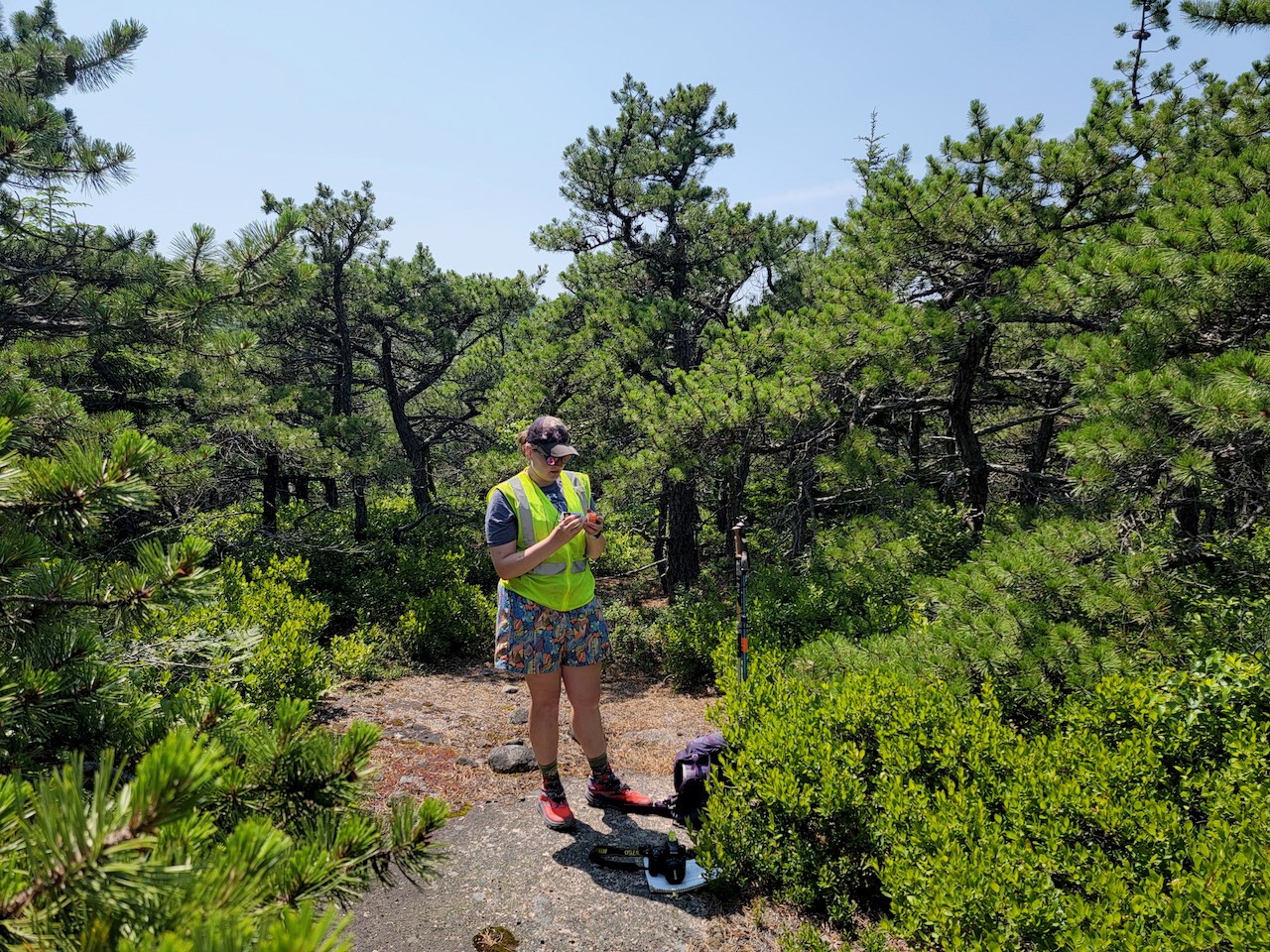
Catherine Schmitt / Schoodic Institute
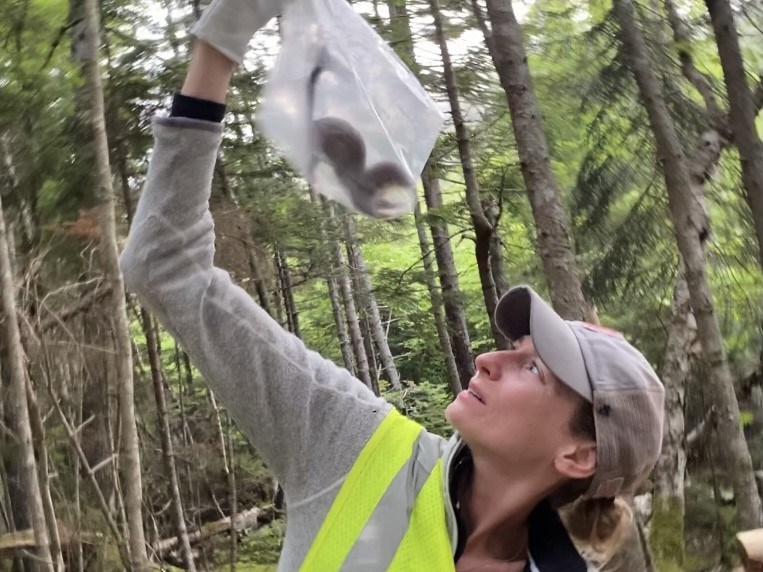
Ellie Jackson / Schoodic Institute
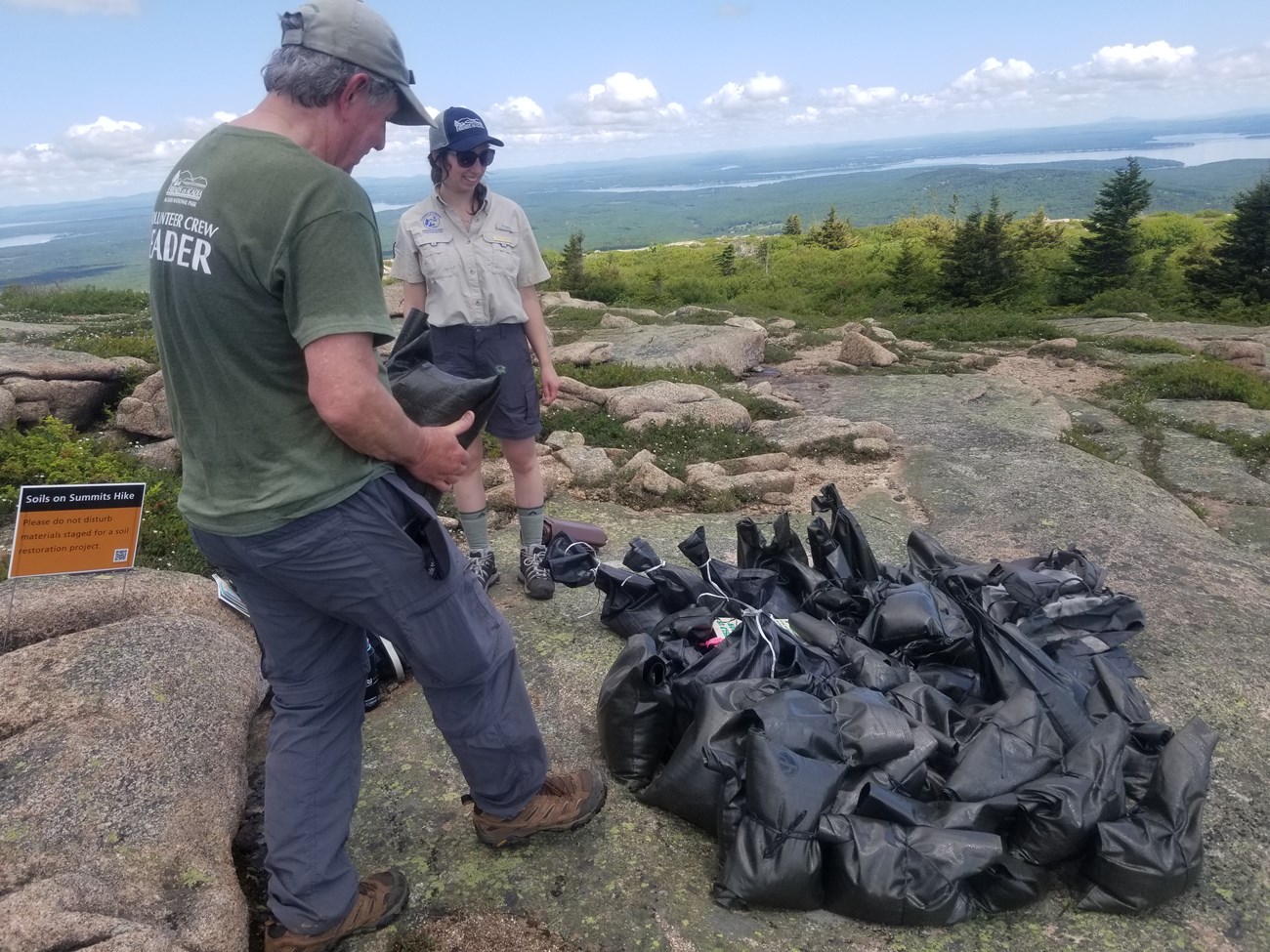
Jack Byrley / NPS Photo
We also continued our work to communicate the great science happening in Acadia. Catherine Devine, a Cathy and Jim Gero Acadia Early-Career Fellow in Science Communication, published three new episodes of the podcast, Sea to Trees. The episodes describe restoration of summit habitats and the documentation of birds and bird songs and how they are changing in Acadia.
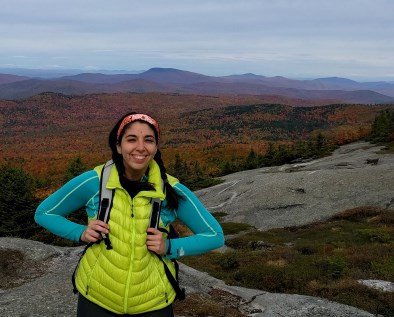
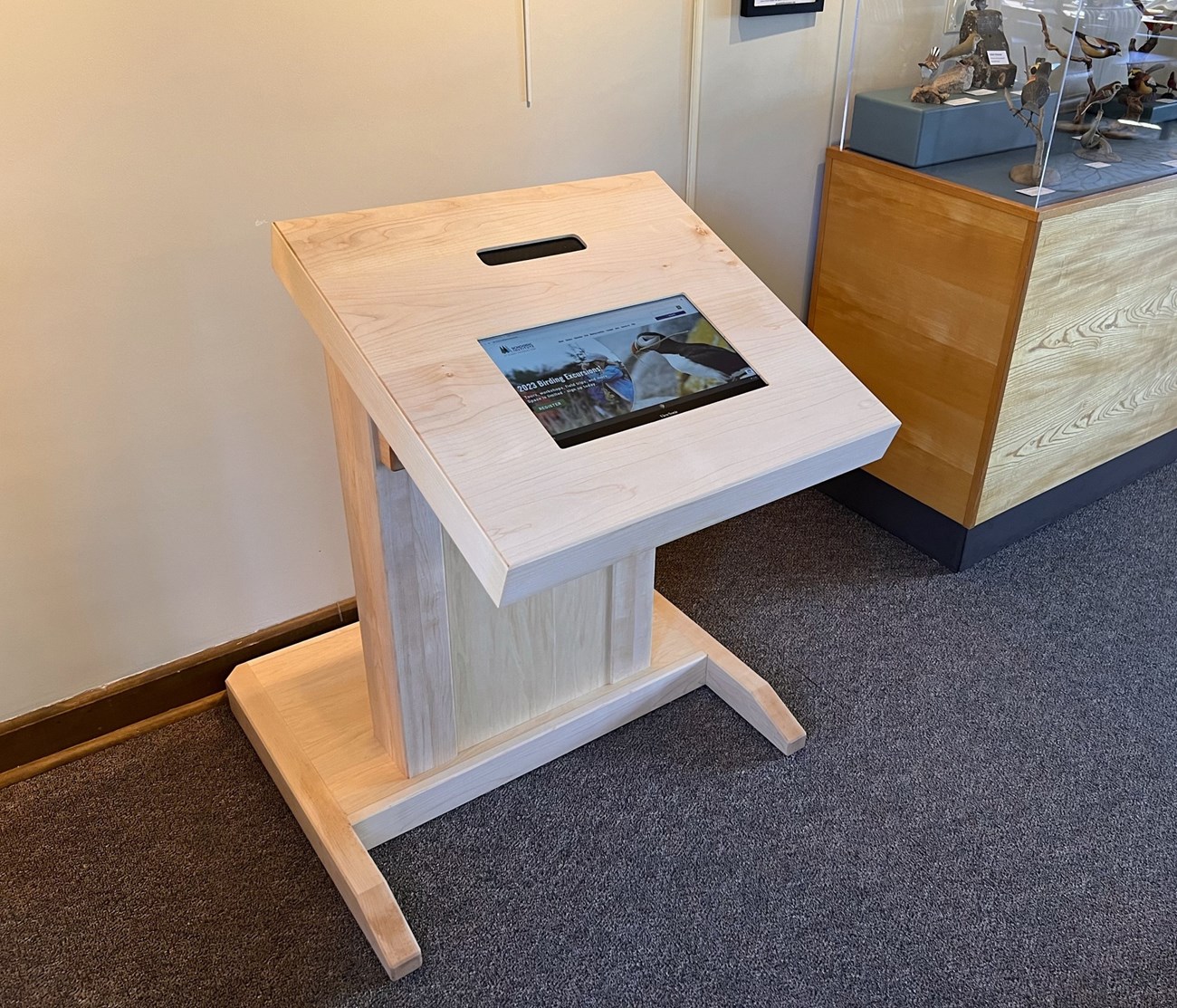
Summary of 2023 Research Projects in Acadia National Park
| Areas of Research | Number of Projects in 2023 |
|---|---|
| Wildlife & Biodiversity | 26 |
| Intertidal & Marine | 19 |
| Plants | 15 |
| Visitor Studies | 10 |
| Freshwater & Air | 7 |
| Pests, diseases, & invasive species | 6 |
| Cultural resources | 1 |
| Geology | 1 |
For more examples of research in Acadia, please visit our Science and Research web page.
The buzz of research activity was not limited to the field. Scientists published at least 39 new publications about research in Acadia, more than in most years.
Acadia National Park 2023 Scientific Research Publications
The following list shows scientific publications that use data or fieldwork from Acadia National Park. The list includes research done by scientists from many institutions.Andrades R, S González-Murcia, TJ Buser, RM Macieira, JM Andrade, HT Pinheiro, CC Vilar, CR Pimentel, JL Gasparini, TL Quintão, FS Machado, G Castellanos-Galindo, G Ruiz-Campos, F Patricio Ojeda, KL Martin, T Giarrizzo, J-C Joyeaux. 2023. Ecology, evolution and conservation of tidepool fishes of the Americas. Reviews in Fish Biology and Fisheries 33: 1263–1290. https://doi.org/10.1007/s11160-023-09798-z
Booker J, C Nadeau, S Saiyed, T Watkins. 2023. Science and public engagement in national parks: Examples and advice from young scientists. Bulletin of the Ecological Society of America 104: e02045. https://doi.org/10.1002/bes2.2045
Boucher C, S Honor, S Lindsay, D McDermott, C Youn. 2023. Visitor mobility at the Hulls Cove Visitor Center in Acadia National Park. Worcester Polytechnic Institute, Worcester, Massachusetts. https://digital.wpi.edu/concern/student_works/n870zv661?locale=en
Butler G, K Ross, J Beaman, C Hoepner, R Baring, K Burke da Silva. 2023. Utilising tourist-generated citizen science data in response to environmental challenges: A systematic literature review. Journal of Environmental Management 339: 117889. https://doi.org/10.1016/j.jenvman.2023.117889
Craig CA, S Ma, S Feng. 2023. Climate resources for camping: A resource-based theory perspective. Tourism Management Perspectives 45: 101072. https://doi.org/10.1016/j.tmp.2022.101072
Descals Ferrando A. 2022. Spatio-temporal variability of vegetation phenology and its drivers at global scale. PhD Dissertation. Univeritat Autònoma de Barcelona. https://doi.org/10.1016/j.envres.2016.02.005
Eisen L, RJ Eisen. 2023. Changes in the geographic distribution of the blacklegged tick, Ixodes scapularis, in the United States. Ticks and Tick-borne Diseases 14: 102233. https://doi.org/10.1016/j.ttbdis.2023.102233
Forest Ecosystem Monitoring Cooperative. 2022. Literature review of monitoring the connection between forest health and outdoor recreation. South Burlington, VT. https://doi.org/10.18125/h9tg50
Fraver S, C Bosely-Smith, C Seirup, CH Guiterman, T Schmeelk, A Teets, R Van Kampen, LS Kenefic. 2023. Dendrochronological reconstruction of arborvitae leafminer (Argyresthia spp.) outbreaks on northern white-cedar (Thuja occidentalis) in Maine, USA. Canadian Journal of Forest Research. https://doi.org/10.1139/cjfr-2023-0193
Garretson A, C Bailey, A Taylor, A Dabulewicz, B Bisson. N Dorn, K Kaczor, MA Nahf, H Webber, M Whiting, J Disney. 2023. Citizen and community science approaches to understanding changes in coastal habitats using Anecdata.org. Maine Policy Review 32: 239-247. https://digitalcommons.library.umaine.edu/mpr/vol32/iss2/43
Greenlaw S. 2023. Mobilizing Indigenous research methodologies and Wabanaki knowledge in biophysical research to restore Wabanaki sweetgrass harvesting in Acadia National Park and identify basket quality black ash habitat for emeral ash borer (Agrilus planipennis) preparedness. Dissertation, University of Maine, Orono. 3914. https://digitalcommons.library.umaine.edu/etd/3914
Grow AK, RS Sleith, TR Sehein, M Labare, LA Katz. 2023. Exploring the diversity of microeukaryotic communities in New England tide pools. Aquatic Microbial Ecology 89: 143-155. https://doi.org/10.3354/ame02003
Gurney G. 2023. ""Smells Fishy": Exploring sense of place salience in community rejection of closed net-pen aquaculture in Frenchman Bay, Maine" (2023). Masters Thesis. 3831. University of Maine, Orono, Maine. https://digitalcommons.library.umaine.edu/etd/3831
Heilakka CC. 2023. Do talus slopes provide hibernacula resources for bats in Maine? Site characteristics associated with winter occupancy and sampling design. Masters Thesis. 3867. University of Maine, Orono, Maine. https://digitalcommons.library.umaine.edu/etd/3867
Huang R. 2023. Analyzing national parks visitor activities using geotagged social media photos. Journal of Environmental Management 330: 117191. https://doi.org/10.1016/j.jenvman.2022.117191
Hubbard JA. 2023. Teaching wonder: Essays and reflections from the National Park System. Masters Thesis. 80. Dartmouth College, Hanover, New Hampshire. https://digitalcommons.dartmouth.edu/masters_theses/80
Katz LS. 2023. Integrating environmental DNA, traditional fisheries techniques, and species distribution modeling to assess bridle shiner status in Maine. Masters Thesis. 3855. University of Maine, Orono, Maine. https://digitalcommons.library.umaine.edu/etd/3855
Lima KA, S Benz, PR Nelson, W Townsend, NA Fisichelli. 2022. Acadia National Park winter birds: 51 years of change along the coast of Maine. Northeastern Naturalist 29: 441-453. https://doi.org/10.1656/045.029.0404
Lombard PJ. 2023. Estimating streamflow for base flow conditions at partial-record streamgaging stations at Acadia National Park, Maine. US Geological Survey Scientific Investigations Report 2022-5126. https://doi.org/10.3133/sir20225126
Lyons S. 2023. Coastal tourism in Maine. Maine Policy Review 32: 214-215. https://digitalcommons.library.umaine.edu/mpr/vol32/iss2/38
Marion JL. 2023. Trail sustainability: A state-of-knowledge review of trail impacts, influential factors, sustainability ratings, and planning and management guidance. Journal of Environmental Management 340: 117868. https://doi.org/10.1016/j.jenvman.2023.117868
Martinez B, H Patel, B Chin, F Cruz, M Usman Awan, H Nasef, A Elkbuli. 2023. Enhancing safety & reducing fatalities in U.S. national parks: An evaluation of injury trends and policy implications in the ten most visited parks. Injury. https://doi.org/10.1016/j.injury.2023.111277
McLagan K. 2023. Understanding community abundance and anthropogenic impact on Acadia National Park’s rocky intertidal ecosystem through photoplot analysis. Honors Thesis, University of Maine, Orono, Maine. https://digitalcommons.library.umaine.edu/honors/811
Meader B. 2023. Drawing Maine: The pictorial maps of the Phillips brothers. Cartographic Perspectives 102. https://doi.org/10.14714/CP102.1877
Miller KM, SJ Perles, JP Schmit, ER Matthews, AS Weed, JA Comiskey, MR Marshall, P Nelson, N Fisichelli. 2023. Overabundant deer and invasive plants drive widespread regeneration debt in eastern United States national parks. Ecological Applications e2837. https://doi.org/10.1002/eap.2837
Nadeau CP, AR Hughes, EG Schneider, P Colarusso, NA Fisichelli, AJ Miller-Rushing. 2023. Incorporating experiments into management to facilitate rapid learning about climate adaptation. Biological Conservation 289: 110374. https://doi.org/10.1016/j.biocon.2023.110374
Nadeau CP, MC Urban. 2023. Macroecological predictors of evolutionary and plastic potential do not apply at microgeographic scales for a freshwater cladoceran under climate change. Evolution Letters arad042. https://doi.org/10.1093/evlett/qrad042
Primack RB, AS Gallinat, ER Ellwood, TM Crimmins, MD Schwartz, MD Staudinger, AJ Miller-Rushing. 2023. Ten best practices for phenological research. International Journal of Biometeorology https://doi.org/10.1007/s00484-023-02502-7
Rodman B. 2023. Evaluating electric bicycle access in US national parks: Advantages and controversy. CMC Senior Thesis, 3394. https://scholarship.claremont.edu/cmc_theses/3394
Schlesinger B. 2023. Nature’s plant hardiness zones. The Millbrook Independent. https://themillbrookindependent.com/?p=3533
Schmalzl L, Z Kieliszek. 2023. Report on good-practice examples to monitor environmental impacts of tourism inside protected areas. Carinthia University of Applied Sciences, Villach, Austria.
Spera SA, KR Spangler, MO Hubert, MG Gorman. 2023. The effects of climate change on the timing of peak fall foliage in Acadia National Park. Landscape Ecology https://doi.org/10.1007/s10980-023-01703-0
Stanley RD. 2023. An assessment of visitor use experience with the implementation of the first-year Cadillac Mountain Summit Road vehicle timed-entry reservation system in Acadia National Park, Maine. Masters Thesis, 3786. https://digitalcommons.library.umaine.edu/etd/3786
Sutton S, J Fraser. 2024. Museums empowering climate action. In Merriman N, ed. Museums and the Climate Crisis. Routledge, NY. doi: 10.4324/9781003347606-3
Thorson RM. 2023. Taxonomy and nomenclature for the stone domain in New England. Historical Archaeology. https://doi.org/10.1007/s41636-023-00432-0
Tsai W-L, NH Merrill, AC Neale, M Grupper. 2023. Using cellular device location data to estimate visitation to public lands: Comparing device location data to U.S. National Park Service’s visitor use statistics. PLoS ONE 18: e0289922. https://doi.org/10.1371/journal.pone.0289922
Weber HM, S Claesson, S Erhart, CV Schmitt, JF Muhlin. 2023. Maine’s potential to be a global leader in sustainable seaweed harvesting and management. Maine Policy Review 32: 70-77. https://digitalcommons.library.umaine.edu/mpr/vol32/iss2/12
Willacker JJ, CA Eagles-Smith, SJ Nelson, CM Flanagan Pritz, DP Krabbenhoft. 2023. The influence of short-term temporal variability on the efficacy of dragonfly larvae as mercury biosentinels. Science of the Total Environment 867: 161469. https://doi.org/10.1016/j.scitotenv.2023.161469
Zoellick B, PV Angione, E Farr, A Fisher, JG Joyce, B Lauer, M McMahan, M Pinkham, V Rea. 2023. Getting to the shore on foot: Sustaining harvester access. Maine Policy Review 32: 100-103. https://digitalcommons.library.umaine.edu/mpr/vol32/iss2/16
2023 Research Permits for Research Conducted in Acadia National Park
Wildlife & Biodiversity
Glen MittelhauserMaine Natural History Observatory
Winter Waterbirds of Acadia National Park: testing new survey methods using a hierarchical modeling framework, and compiling historic survey records
Timothy Divoll
Brown University
Acadia bat data management system
Stephen Ressel
College of the Atlantic
Breeding by the Sea: Coastal Vernal Pools in Acadia National Park as Breeding Habitat for Spotted Salamanders (Ambystoma maculatum)
John Anderson
College of the Atlantic
Seabird Survey of Acadia National Park islands
Brittany Slabach
Trinity University
How landscape ecology and human disturbance shape small mammal communities
Evan Graham Hegeman
University of Connecticut
Threespine stickleback and cestode parasites in Maine waters
Aaron Weed
National Park Service, Northeast Temperate Network
Forest Bird Monitoring at Acadia National Park
Laura Sebastianelli
Bird Sound Recording to Enhance Bird Ecology Research at Acadia National Park
Gregory LeClair
University of Maine, Orono
Parameterizing Environmental DNA Detection for the Conservation of Threatened Turtles
Seth Benz
Schoodic Institute at Acadia National Park
SeaWatch: A Citizen Science Monitoring Project of Fall Seabird Migrations off Schoodic Point in Acadia National Park
Seth Benz
Schoodic Institute at Acadia National Park
Long-term Monitoring of Fall Raptor Migrations in Acadia National Park (using standard data collection protocol as defined by the Hawk Migration Association of North America)
Seth Benz
Schoodic Institute at Acadia National Park
Schoodic Institute Biodiversity and Phenology Citizen Science Observations related to restoration and Wild Acadia
Craig Lowe
Duke University School of Medicine
Exploring Genetic Differentiation of Marine and Freshwater Stickleback Populations across North American East Coast Latitudinal Gradient
Bik Wheeler
National Park Service, Acadia National Park
Protecting WNS Affected Bat Populations in Acadia National Park: Monitoring and Mitigation
Joshua M Guilbert
Biodiversity Research Institute
Conserving White Nose Syndrome (WNS) Affected Bat Populations in Acadia National
Joshua M Guilbert
Biodiversity Research Institute
FHWA Projects ME NP ACAD BRG(1), ME NP ACAD BRG(2), and ME NP ACAD BRG(3) Acadia National Park, Hancock County, ME Bat Surveys
Michela Corsini
Boise State University
Rewilding the night sky: Mitigating the costs of light pollution in protected areas
Pooja Panwar
Dartmouth College
Quantifying food resource available to Bats and Birds at Acadia National Park
Rebecca Cole-Will
National Park Service, Acadia National Park
Monitor wildlife along utility corridor using wildlife cameras
Matt O'Donnell
US Geological Survey
Use of the marine environment by brook trout in Stanley Brook; Acadia National Park, Maine
Charles Lubelczyk
MaineHealth Institute for Research
Mosquito Surveillance
Hannah Mittelstaedt
University of Maine
UMaine Course: Field Research Experience in Ecology and Environmental Sciences (EES 217)
Chloe Meyer
College of the Atlantic
The impacts of precipitation frequency on juvenile body size in Eastern small-footed bats (Myotis leibii)
Emma Albee
Schoodic Institute at Acadia National Park
eBird observations in Acadia National Park
Emma Albee
Schoodic Institute at Acadia National Park
iNaturalist observations in Acadia
Glen Mittelhauser
Maine Natural History Observatory
Winter Waterbirds in the Isle au Haut region of Acadia National Park
Intertidal & Marine
Catherine SchmittSchoodic Institute at Acadia National Park
King Tide & Storm Monitoring
Susan Brawley
University of Maine (Orono)
Experimental Evolutionary Cell Biology Using the Porphyra Model System
James Lynch
National Park Service, Northeast Region
Elevation monitoring of salt marsh habitats at Acadia National Park
Alexa Pezzano
National Park Service, Acadia National Park
Schoodic Education Adventure, Intertidal Exploration
Morgan Simms
EA Engineering, Science, and Technology, Inc., PBC
Improving Coastal Resiliency on St. Croix Island, Maine
Morgan Simms
EA Engineering, Science, and Technology, Inc., PBC
Coastal Engineering Review of Impacts of the Causeway on the Health of the Coastal Ecosystem Acadia National Park (ACAD) Otter Creek, Maine
Catherine Matassa
University of Connecticut
Intertidal community assembly and dynamics: Integrating broad-scale regional variation in environmental forcing and benthic-pelagic coupling (NSF Award OCE-1458150)
John Cigliano
Cedar Crest College
Marine microplastics in Acadia National Park
John Cigliano
Cedar Crest College
The effects of ocean acidification and climate change on temperate marine rocky intertidal communities
Hannah Webber
Schoodic Institute at Acadia National Park
Marine-to-land subsidies in Acadia National Park's Big Moose, Little Moose, and Pond Islands
Hannah Webber
Schoodic Institute at Acadia National Park
Project ASCO (Assessing Seaweed via Community Observations)
Hannah Webber
Schoodic Institute at Acadia National Park
Biodiversity of select soft sediment habitats of Acadia National Park
Hannah Webber
Schoodic Institute at Acadia National Park
Phenology of Jonah crab (Cancer borealis) appearance on Schoodic Peninsula
Michele LaVigne
Bowdoin College
Understanding Paleoceanographic Proxies and site-specific calibrations using crustose coralline algae
Adam Kozlowski
National Park Service, Northeast Temperate Network
NPS Northeast Temperate Inventory and Monitoring Network (NETN) Rocky Intertidal Monitoring Program
Chris Petersen
College of the Atlantic
Clam recruitment and predation, and pH in intertidal mudflats
Kaitlyn Armstrong
MDI Biological Laboratory, Community Environmental Health Laboratory
Water Monitoring at the Bar in Bar Harbor
Hannah Webber
Schoodic Institute at Acadia National Park
Assessing Eelgrass Flowering Density and Seed Maturity
Michelle Baumflek
USDA Forest Service, Southern Research Station
Protect Natural Resources by Developing Plant Gathering Protocols with Indian Tribal Gatherers
Plants
Jeff LichtUniversity of Massachusetts, Boston
Exogenous and endogenous factors affecting persistence of Pinus banksiana in Acadia National Park
Nicholas Fisichelli
Schoodic Institute at Acadia National Park
Impacts of extreme climate events on tree regeneration in the Northern Forest
Aaron Weed
National Park Service, Northeast Temperate Network
Forest Health Monitoring at Acadia National Park
Finley O'Connor
College of the Atlantic
Seabirds and Vegetation: Characterizing Colony Nesting Habitat on Outer Maine Islands
Michael Piantedosi
Native Plant Trust
The New England Plant Conservation Program (2020-2024)
Chance Noffsinger
University of Tennessee, Knoxville
Systematic analysis of Russula in Spruce-Fir habitats of Eastern North America
Christopher Nadeau
Schoodic Institute at Acadia National Park
Does Enhancing Genetic Diversity Increase the Long-term Success of Subalpine-Plant Restorations Under Climate Change
Jill Weber
College of the Atlantic
Rare Plant Monitoring on Cadillac Mountain Summit
Christopher Nadeau
Schoodic Institute at Acadia National Park
Monitoring Climate Change Refugia using Citizen Science
Christopher Nadeau
Schoodic Institute at Acadia National Park
A Seed Bank Germination Study to Predict Future Wetland Vegetation in Great Meadow
Christopher Nadeau
Schoodic Institute at Acadia National Park
Wetland Monitoring and Invasive Species Suppression in Great Meadow and Bass Harbor Marsh
Christopher Nadeau
Schoodic Institute at Acadia National Park
Acadia Summit Restoration Project
Jeffrey Harriman
Maine Forest Service
Northeast Forest Inventory and Analysis
Jay Wason
University of Maine
Climate limits on tree germination, establishment, growth, and survival
Emma Albee
Schoodic Institute at Acadia National Park
Nature's Notebook observations in Acadia National Park
Visitor Studies
Earnestine RobinsonNorth Central University
A Qualitative Exploration of the Leadership Journeys of Black Women in the National Park Service
Julia Goolsby
University of Colorado Boulder
How institutional context and emotions shape manager decisions to resist, accept, or direct change in transforming ecosystems: A cross-case study in four national parks
Adam Gibson
National Park Service, Acadia National Park
Acadia Carriage Road Visitor Use Study
Jill Weiss
State University of New York College of Environmental Science and Forestry
Managing the New Hiker: Characteristics, Perceptions, and Behavior Trends among Trail Users in the Northeast
Frederick Bianchi
Worcester Polytechnic Institute
Dark Sky
Frederick Bianchi
Worcester Polytechnic Institute
Sound Analysis
Frederick Bianchi
Worcester Polytechnic Institute
Visitor Mobility at the Visitor Center
Frederick Bianchi
Worcester Polytechnic Institute
Effectiveness of License Plate Readers
Frederick Bianchi
Worcester Polytechnic Institute
WPI/Acadia Trails Website
Laurel Shanks
Friends of Acadia
Understanding Visitor Motivations in Transportation Decision-Making in Acadia National Park, Maine
Freshwater & Air
Jeremy DeedsMaine Department of Environmental Protection
Regional Lake Monitoring Network
Kathryn Miller
National Park Service, Northeast Temperate Network
Freshwater Wetland Monitoring at Acadia National Park
Glen Mittelhauser
Maine Natural History Observatory
Assess water levels and vegetation in Great Meadow – 2023
Alexis Dabulewicz
MDI Biological Laboratory, Community Environmental Health Laboratory
PFAS Testing of Watersheds Surrounding MDI High School
Grace Johnson
University of Maine
Interpreting the extent and characteristics of microplastics pollution in Maine freshwater streams to guide a holistic mitigation strategy
Hannah Webber
Schoodic Institute at Acadia National Park
The Dragonfly Mercury Project – engaging citizen scientists in monitoring mercury contamination in National Parks
Abigail Quinn
Bates College
Water Samples from Acadia National Park Lakes
Pests, Diseases, & Invasive Species
Caroline KanaskieUniversity of New Hampshire
Protecting coastal pitch pine in Acadia National Park by predicting southern pine beetle risk
Angela Mech
University of Maine
Lure efficacy trial for the invasive browntail moth (Euproctis chrysorrhoea)
Jesse Wheeler
National Park Service, Acadia National Park
Emerald Ash Borer surveys using trap trees in Acadia National Park
Jesse Wheeler
National Park Service, Acadia National Park
Emerald Ash Borer Survey and Outreach
Jesse Wheeler
National Park Service, Acadia National Park
Southern pine beetle monitoring
Cameron McIntire
USDA Forest Service
Long-term monitoring of beech leaf disease (BLD)
Cultural Resources
Rebecca Cole-WillNational Park Service, Acadia National Park
Conduct Non-invasive monitoring of archeology sites
Geology
Alexa PezzanoNational Park Service, Acadia National Park
Schoodic Education Adventure, Soil Exploration
